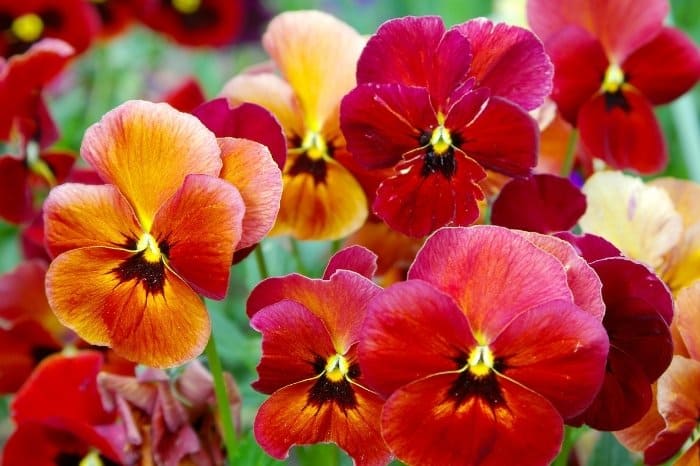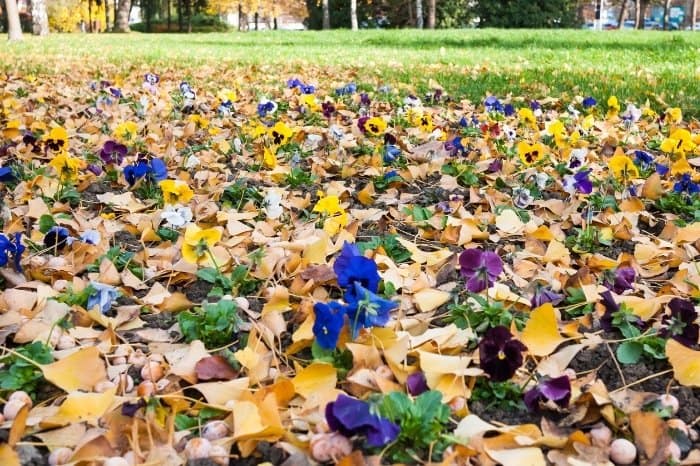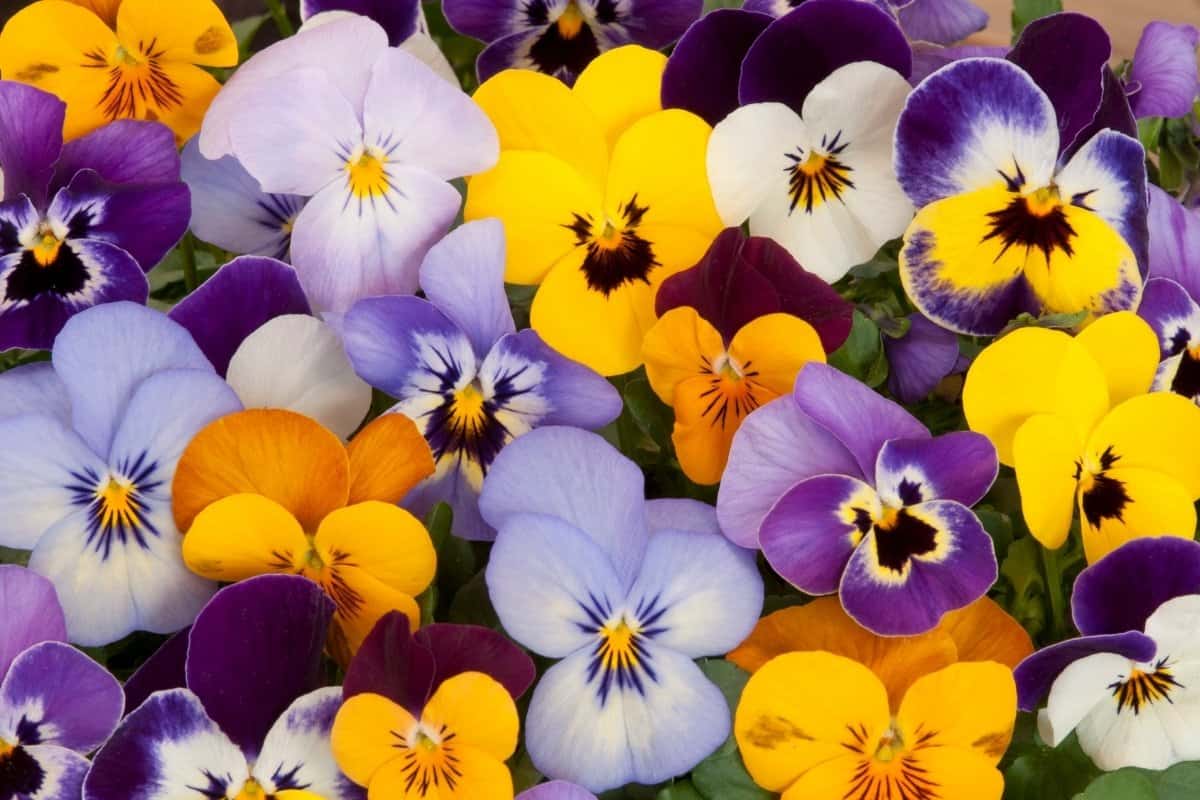Last Updated on June 30, 2021 by Cristina
Is the pansy plant a fan of sun or shade, or what temperature should it be exposed to and expected to thrive when it’s growing?
Pansies are easy to grow and recommended for newbie gardeners who want to grow them as bedding plants. These flowers require minimal care and provide you with a very long flowering season. They are available in a variety of colors and mixes, producing a beautiful bloom.
Pansies can either grow from pansy seeds indoors or sown directly in the garden. These cool-weather favorite flowers are great for spring and fall gardens.
They are good for borders, pots, and ground cover, reliable for color almost all year round. They look pretty in a monochrome scheme or mixed colors and when planted among other cool-season flowers like the primroses, violas, sweet alyssum, and trailing lobelia.
Facts About Pansy Flowers
- Modern pansies began growing as a small European wildflower- Viola tricolor commonly known as Johnny-jump-up.
- It was believed to be Shakespeare’s little Western flower.
- This flower has five rounded petals arranged like a butterfly.
- The blooms are much smaller, less than an inch wide.
- Their color is either deep purple or a combination of yellow, purple, and white.
- Wild pansies tend to form natural hybrids.
- These flowers thrive in the spring and fall seasons when few flowers are blooming.
- They fill the gardens with color and subtle fragrance.
- They are edible flowers favored by prominent chefs across the world.
- These flowers stand out with their aroma, color, and flavor for fresh cuisine, bouquets, and gardens.
- They are derived from common woodland flowers.
- There have hundreds of varieties to choose from.

Do Pansy Flowers Need Sun Or Shade?
Pansies thrive during cool nights and warm days of spring and fall. Even frosts and freeze do not stop these flowers from blooming.
Fall planted pansies in some moderate southern winters thrive under this weather. On the northern side, fall-planted pansies bloom during the fall, provide colorful blooms in the fall, and take a winter break only to reappear to bloom alongside the daffodils, early tulips, and other spring-blooming flowers.
As the temperatures get high and warm, these flowers gradually dwindle and die with the summer heat arriving. Fall planted pansies have larger, more numerous spring blooms and do not tolerate sun, but spring-planted ones might tolerate heat better.
Bottom-line, these flowers enjoy shade or cool weather all the way. During the hot weather in summer, most of them tend to die even when kept away from the direct sun because the temperatures are high.
Growing Pansy Under Sun Or Shade
Pansies thrive in a cooler climate. Therefore, plant them in spring or fall. Plant them on well-drained soil that has high organic matter.
Spring Planting
Pansies thrive when the soil temperatures range between 45 to 65 degrees F. Spring planting roughly coincides with your normal early vegetable planting. In the Northern gardens, the pansy displays are longer than in the south, where summer comes fast, and pansies leave quickly.
Even so, it’s crucial not to plant too soon. Too much cold stresses the pansies causing stunted growth, poor flowering, and discoloration. Use a soil thermometer to determine if the temperature is right for planting during spring. You can buy the thermometer at a hardware or garden store near you.
Fall Plantings
Pansies can also be planted in the fall after the summer sun has cooled and the soil is good for planting. It would help if you also gave your pansies enough time to establish their roots before winter comes. A proper root system will help your pansies survive winter. Small flowering pansies display the greatest resilience against cold.

Helping Pansies Re-bloom
Pansies will flower more and longer if you remove the spent flower heads. During the hot months, cut the plants back and mulch to keep the moisture. When cooler weather returns, the pansies will reward you with a second show of blooms.
According to your area, pansies are very hardy plants that can be set out at least a month before the frost date. After a week or so after planting, you can put the plants outside if you are growing them in pots or plant them in the garden beds and left outside. They will survive the cold without any problems.
When planted in the fall, pansies can withstand mild winters and re-bloom gloriously in the spring. A layer of straw mulch can be applied as soon as the temperatures fall below freezing to protect your pansies through the cold winter.
Common Pansy Insects And Diseases To Avoid
Pansies do not generally attract insects or diseases, but some affect them. They include:
Slugs. Slugs are common pests that will not pass a bed of pansies. You can set a trap to catch them where they are common or sprinkle a bit of diatomaceous earth around the plants.
Mildew or Fungi. If you observe signs of mildew and fungi, take a leaf sample to a garden center for correct identification and treatment.
Garden Safe 4536 Slug & Snail Bait (HG-4536) (2 lb)
Varieties Of Pansy
If you want various colors and still want to plant the same plants with the same cohesion, pansies will be a go-to flower. They are similar in size and markings, regardless of color.
- Bingo series. This large-flowered type comes in 14 colors, including burgundy and pale blue. The blooms come in earlier than the popular Majestic giants’ type.
- Bolero type. These are large, ruffled, semi-double flowers. This type does well in the fall and spring.
- Cool wave type. These fast-growing vigorous blooms have a habit of spreading like cool wave petunias. They are good spillers for container plants.
- Joker type. This type has very pronounced faces that are bicolored n complementary colors.
- Freefall habits. These day-neutral, trialing plants are great for containers or gardens where you are not growing other plants. Just like their name, they are free to roam around the area or spill from the containers.
- Princess type. This type has compact growth habits and dainty flowers. It comes in monochromatic tones from cream to deep purple with yellow centers.
Conclusion
Pansy sun or shade? You now know the harm sun will cause your beautiful pansies, so plant them in the fall and wait to enjoy these beautiful colored blooms to brighten your spring.
Caroline is a gardener who loves to get down to the nitty–gritty of gardening. She proudly proclaims herself as a ‘dirt worshipper‘ and can often be found deep in the garden, covered in soil and singing to her plants. As a self–proclaimed ‘plant whisperer‘, Caroline believes that plants need love and attention just like any other living thing, and she loves to give them both. When she‘s not tending to her garden, you can often find her researching the latest gardening trends, or teaching others how to make their gardens thrive



